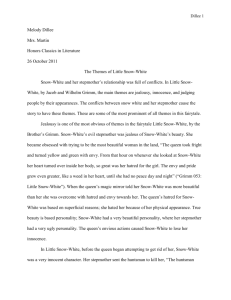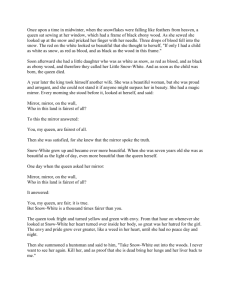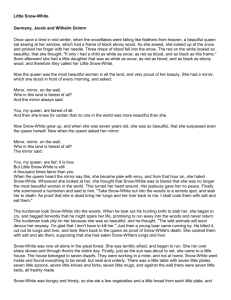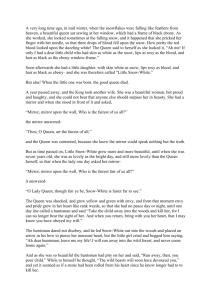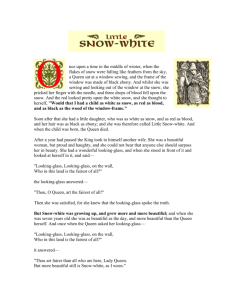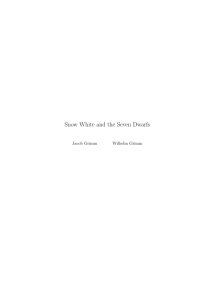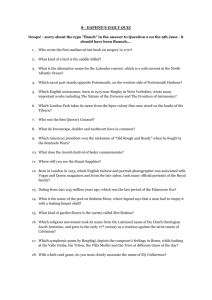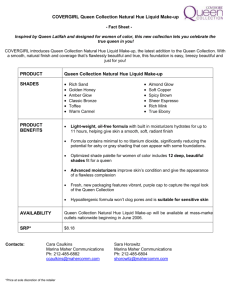Samantha Gross Midterm Essay February 9, 2014 The Fairest of
advertisement
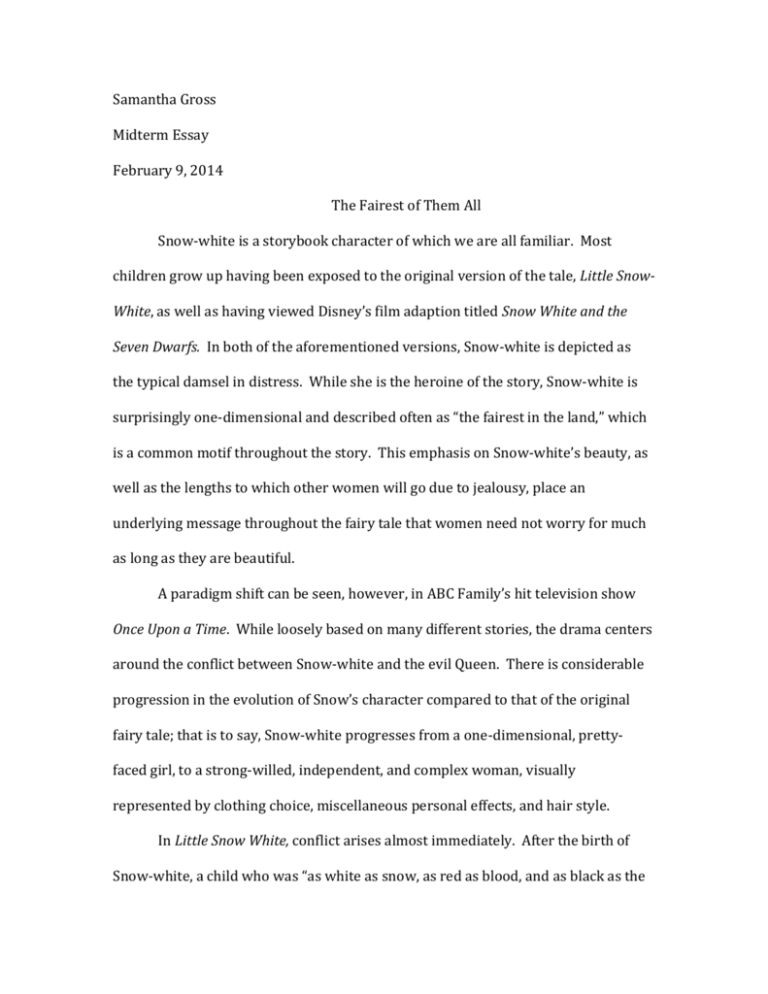
Samantha Gross Midterm Essay February 9, 2014 The Fairest of Them All Snow-white is a storybook character of which we are all familiar. Most children grow up having been exposed to the original version of the tale, Little SnowWhite, as well as having viewed Disney’s film adaption titled Snow White and the Seven Dwarfs. In both of the aforementioned versions, Snow-white is depicted as the typical damsel in distress. While she is the heroine of the story, Snow-white is surprisingly one-dimensional and described often as “the fairest in the land,” which is a common motif throughout the story. This emphasis on Snow-white’s beauty, as well as the lengths to which other women will go due to jealousy, place an underlying message throughout the fairy tale that women need not worry for much as long as they are beautiful. A paradigm shift can be seen, however, in ABC Family’s hit television show Once Upon a Time. While loosely based on many different stories, the drama centers around the conflict between Snow-white and the evil Queen. There is considerable progression in the evolution of Snow’s character compared to that of the original fairy tale; that is to say, Snow-white progresses from a one-dimensional, prettyfaced girl, to a strong-willed, independent, and complex woman, visually represented by clothing choice, miscellaneous personal effects, and hair style. In Little Snow White, conflict arises almost immediately. After the birth of Snow-white, a child who was “as white as snow, as red as blood, and as black as the wood of a window-frame,” the Queen passed away and the King remarries. (Grimm, 249) His new wife was a beautiful, yet haughty woman whom above all, “could not bear that anyone else should surpass her in beauty.” (249) Snow-white, however, was described by the Grimm Brother’s to grow more beautiful with age, “and when she was seven years old she was as beautiful as the day, and more beautiful than the Queen herself.” (250) The Queen, speaking into the famous looking glass, finds out that she is no longer the most beautiful woman in the land, and spends the rest of the tale trying to murder her stepdaughter out of spite. While Snow-white’s physical features are the catalyst of the Queen’s envy, it is her physical features that always seemingly save her life as well. For example, when the Queen sends a huntsman to kill her stepdaughter, the huntsman “had pity on [Snow-white]” because “she was so beautiful.” (250) When Snow-white takes refuge at the cottage of the seven dwarfs, they find her sleeping in one of their beds and proclaim, “Oh, heavens! oh, heavens…what a lovely child!” (252) And lastly, when the Queen finally succeeds in sending her stepdaughter into a sleeping death via the poisoned, red apple, her beauty once again manages to save her life when the Prince happens to stumble upon her glass coffin. He proclaims to the dwarfs that he must have Snow-white “for I cannot live without seeing [her]...I will honor and prize her as my dearest possession.” (257) The Grimm Brother’s descriptions of Snow-white focus on her beauty, innocence, and purity. These images are further interpreted in Disney’s film adaption, wherein the seven dwarfs are fleshed out and given life while leaving Snow-white’s disposition generally in-tact to the original tale. Snow-white is drawn with soft, blended colors, and given no physical imperfections. She is almost always shown wearing her iconic yellow and blue gown which emphasizes her hourglass figure. One of the only times that Snow-white is seen wearing a different outfit is when she dons rags in order to clean. In many instances, the outfit of a maid, or the image of a woman cleaning in a dress, is extremely sexual and places that sexuality upon the woman in a negative light. However, in the case of Snow-white, the outfit of the maid highlights her innocence. Snow was born a princess, and to see a highborn woman wearing rags accentuates her kindness and extreme goodness. Unfortunately, Snow-white is innocent to a fault, and gets duped by the evil Queen when the Queen, disguised as an old beggar woman, tricks Snow-white into eating a poisoned apple which sends her into a sleepless death. These images of Snow-white, and the extreme emphasis on her beauty, say a lot about how society views women. To really think that a Prince would want to take a seemingly deceased woman back to his palace because he wanted to look upon her face, is a rather disturbing thought. Not to mention, in Disney’s re-telling of the tale, the Prince actually removes the lid of the coffin and kisses her lips. Snow-white is seen as nothing more than something pretty to look at, and paradoxically, it is those same attractive physical features that leads the Queen to poison her in the first place. And while there is no hope for the Brother’s Grimm to redeem themselves, or the message that they are sending to young girls and women, Disney was given the unique opportunity to once again retell the story of Snowwhite, on the hit ABC Family television show entitled Once Upon a Time. Once Upon a Time puts Snow-white and Prince Charming at the center of the drama and takes place in two different worlds: the Enchanted Forest and Storybrooke, Maine. In the flashbacks to life in the Enchanted Forest, we encounter Snow-white many times, repeating patterns that stem from the Brother’s Grimm. For example, Snow-white is frequently shown on the run from both the Queen and her huntsman. The major exception is that she is no longer helpless, which is shown by the clothing choices selected for her character, miscellaneous personal effects, and hairstyle. While at times still wearing dresses, one of the most notable deviations from the image of Snow-white that we hold in our minds, is her character in Once Upon a Time wearing loose fitting pants and shirts. Although the original version of this tale does not give a description of Snow-white’s clothing, one can assume that as she ran from the huntsman she was ill prepared for a flight into the woods. The most iconic image of Snow-white is that of the Disney animated film, wherein our heroine is garbed in a beautiful gown that gets torn to shreds as she faces the dangers of the wood. In Once Upon a Time, however, Disney does much to counteract this image of a helpless girl who flees for her life in nothing but a ball gown. Snow-white is also depicted carrying weapons. She is seen with knives, swords, and a bow and arrow, of which she is quite proficient. This is perhaps the biggest change from the original, because putting a weapon in Snow-white’s hand is completely divorcing her character to the “damsel in distress” trope. She can no longer be considered just a pretty face, and in fact, is now Prince Charming’s equal rather than a just a woman to be saved. Not only can she defend herself, she can also defend her friends and cause physical harm to the Queen if need be. The last of the visual techniques that will be discussed is hairstyle. Once Upon a Time utilizes this with Snow-white as Mary-Margaret in Storybrooke, Maine by choosing to have Mary-Margaret’s hair kept in a very short, cropped cut. Short hair is seen socially as a political statement that women make to reclaim themselves as a human being, rather than someone who must be appealing at all times to men. Long hair is seen as very feminine, and generally men are attracted to women who keep their hair as such. Because Snow-white’s character in Little Snow-White is so extremely feminine, it is no such wonder that the illustration coupled with the version of the Grimm Brother’s tale used in this analysis, depicts Snow-white with flowing hair down past her shoulders. And while the animated Disney film shows Snow-white with her hair worn in a bob, her hair still has body and movement while Mary-Margaret’s hair has no such fluidity. “Who is the fairest of them all?” are famous words that almost everyone recognizes; words that place emphasis on beauty as strength, rather than strength of character. This is the message that is being sent to those who are familiar with this story: that beauty is power, and if you are beautiful life is going to be quite easy. The television show Once Upon a Time does much to undo and counteract Little Snow-White, most importantly by showing that whether it be dwarfs or men, Snowwhite asserts not only her ability to cope and survive on her own but that she is capable of saving their lives just as much as they are capable of saving hers. A message like that cannot be concluded when one finishes reading Little Snow-White, because her tale is the tale of a girl doomed to be a victim of her beauty, rather than living independently from it. A still from Snow White and the Seven Dwarfs Snow White as seen on the television show Once Upon a Time.
